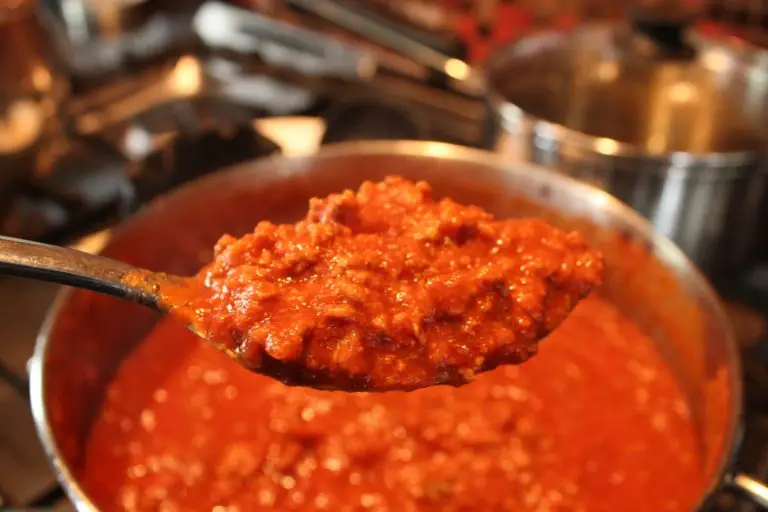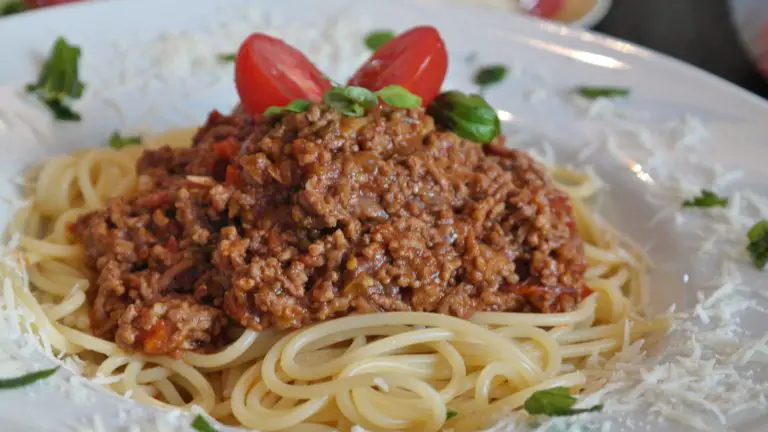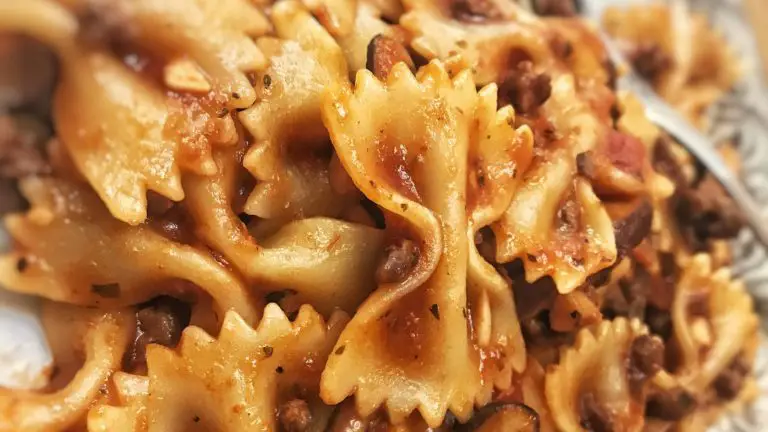Ragù alla Bolognese:
the Authentic Italian Recipe
Bolognese sauce (or “Ragù alla Bolognese”, as we call it in Italy) is one of the most well-known sauces for pasta. Meaty, juicy and just delicious on tagliatelle, it takes a few hours to get that rich taste, but the wait is worth it!

→ Disclaimer: this article is about ragù alla bolognese, the meat sauce. “Spaghetti alla Bolognese” is a different dish. Spaghetti alla bolognese is a typical dish from Bologna, topped with a pasta sauce made of tuna and peeled tomatoes – yes, tuna, not meat!
Still confused? Read my article Italian food that you won’t find in Italy.
As people had been making their own version of ragù for centuries, the Italian Academy of Cuisine finally decided to have it officialized, having at heart the future of the authentic Bolognese sauce.
After years of debates and fights about the ingredients, cooking time and techniques used to make the perfect sauce, the ragù alla bolognese authentic recipe was officially recorded and deposited on October 17th, 1982, at the Bologna Chamber of Commerce.
Today, this recipe represents a people’s history and has become well-known all over the world.
Just remember that “sugo” and “ragù” aren’t the same thing. “Sugo” (meaning “sauce”) is an umbrella term for any sauce you can dress pasta with – even vegetarian versions!
Let’s see the recipe of ragù alla bolognese: how to make the authentic bolognese sauce from scratch and how it’s used in the Italian cuisine.
1. The Origins of Ragù
The term “ragù” probably derives from the French “ragôuter”, which means “awakening appetite”. It is believed that it was Louis XIV of France who first had the idea of a pasta sauce, even though the first documented recipe belongs to chef Alberto Alvisi from Imola, near Bologna. Later on, the famous writer and gastronome Pellegrino Artusi included a meat sauce recipe named “bolognese” in his best-seller “Science in the kitchen and the art of eating well” in 1891.

2. Ragù alla Bolognese Authentic Italian Recipe - in 5 Easy Steps!
The recipe you’re about to read is based on the original one deposited at the Bologna Chamber of Commerce by the Italian Academy of Cuisine in 1982. Of course, you can tweak it according to your taste!
INGREDIENTS for 4 people:
- Beef (minced beef, coarsely ground and mixed) 300 g
- Tomato puree 300 g
- Carrots 40 g
- Celery 40 g
- Golden onions 40 g
- Bacon 150 g
- Dry white wine 250 ml
- Vegetable broth 250 ml
- Extra virgin olive oil
- A glass of milk
- Salt
- Black pepper
Instructions:
- Start your ragù alla bolognese by putting a large saucepan on medium heat and add 1 tbsp of extra-virgin olive oil. Then add minced bacon and let it brown.
- Add finely chopped onion, celery and carrot. Let it simmer for 5 mins, until veggies have softened.
- Increase the heat to medium-high and add ground beef. Pour a splash of dry white wine on the meat and let it sizzle until the meat is browned all over.
- Then add the vegetable broth – must cover the meat – and tomato puree.
- Gently simmer for 2 hours until thickened. Stir every now and then so as to cook everything evenly. A few mins before turning off the heat, add the glass of milk. Et voilà! Add salt and pepper to your taste and serve it on your pasta.

3. Tips for the Perfect Ragù alla Bolognese
To make your life easier, here you are 7 Tips for an Easy Damn Delicious Ragù alla Bolognese.
3.1 Type of meat: Italian sausage, pork or beef?
If you want to follow the authentic Bolognese sauce recipe, you must use the fattest parts of the pork leg and beef. If you want to spice it up a bit you can add a little sausage pulp, possibly sweet and not too spicy. Asking your butcher to mince the meat is a great idea – and saves you a lot of work.
3.2 Should I add any spices or aromatic herbs?
The protagonist of ragù alla bolognese is undoubtedly meat and, to preserve its taste, no spices should be added: no parsil, no rosemary, no garlic. Not even nutmeg, even though some families use it. During the last century, in Emilia, the bolognese sauce was made with meat from old cows that weren’t able to work in fields any longer. For this reason, it was necessary to simmer for 5 or 6 hours and add milk or cream that breaks meat fibers and gives it a bit of sweetness.
Nowadays it’s different. We only need 2-3 hours for simmering and milk is not indispensable anymore.
3.3 Cooking time: can I make a rapid ragù?
Well, you could do that, but it won’t taste as good as the authentic bolognese sauce. The best ragù are those that simmer for at least 2 hours. During this time, check whether it is necessary or not to add some broth and, while you are at it, give it a stir so that everything cooks perfectly and evenly.
I know the procedure is long and involves several techniques (sweating, sautéing and braising), but don’t let it discourage you. It’s not that difficult to make, so give it a try!
—> You may also like
Mac n Cheese Mysterious Origins: American, English or Italian?
3.4 Use the right tools: slow cooker, crockpot or pressure cooker?
Earthen pots or non-stick sauce pans are ideal for long cooking time recipes, however you can also use pressure cookers – if you don’t have time. Slow cookers and crockpots are the most common types of pot and they work just fine.
3.5 How to store ragù
Ragù alla Bolognese can be kept in the fridge in airtight containers for 2-3 days. You can also meal-prep it and store it in single portions to keep in the freezer, ready to use.
Remember that before putting the meat sauce in the fridge or freezer, you must let it cool down completely.
3.6 Tomatoes: better use a jar sauce, tomato puree or fresh tomatoes?
As I mentioned before, there are different varieties of ragù. The type of tomato you use can really affect the taste of your sauce, so I honestly recommend you to try different types – and brands – and see which version is the best for you.
I personally like to use crushed tomatoes (polpa di pomodoro) as I find it less sweet than tomato puree (passata di pomodoro), but I recommend you to try both and see what you like best.
3.7 Milk or heavy cream?
A glass of milk is highly recommended: why? First of all, it gives the sauce that nice orangish color and, secondly, it makes it reach the right creaminess. Heavy cream can be added as well, especially on dry pasta. However, if you want to serve it on tagliatelle, cream is not ideal.
4. How to Serve Ragù: Not Only Pasta!
Ragù is such a versatile recipe that even if you have some leftovers you can use it in many different ways:
- it can be served on fresh homemade pasta made of eggs and wheat flour, usually flat shaped pasta like tagliatelle, pappardelle, fettuccine, or else tube shaped rigatoni, penne and mezze penne.
- in lasagne, between the oven-baked layers of lasagna pasta together with a smooth and creamy besciamella.
- on top of polenta (so yummy!)

—> You may also like
5. Best Types of Pasta with Bolognese Sauce
Among homemade (and non-homemade) types of pasta, there are some shapes that are better than others. Just remember, the bigger the pasta size, the more complex the sauce should be. With the right match pasta-ragù you’ll get the perfect dinner to present to your guests!
Get inspiration from the following best pasta types with Bolognese sauce:
- flat and long pasta: tagliatelle are a classic with Bolognese sauce, but you can also use fettuccine; ziti are often chosen for Neapolitan ragù (see “varieties of ragù” below); lasagnette and pappardelle are ideal with game sauce as they are thicker and more structured, ideal for stronger flavors.
- flat and squared pasta: ragù goes perfectly with lasagne and can be used also for maltagliati (rhomboidal uneven cut pasta).
- short shaped pasta: maccheroncini are a great match for Neapolitan ragù; rigatoni for a classic Bolognese or any other ragù, while paccheri a the favorite pasta for a fish ragù. Or else, why not gnocchi?

—> You may also like
6. All Varieties of Ragù in Italy
Ragù recipes differ from region to region, sometimes even province to province!
Here I listed all regional varieties of ragù and their main ingredients. Just keep in mind that no matter where you go in Italy, each family has always their own interpretation of the original recipe:
- Tuscan ragù: similar to bolognese sauce but with aromas like thyme and bay leaves.
- Genoese ragù: defined the “white sauce” as there is no tomato or tomato sauce in the recipe, it’s made with beef and tons of onions.
- Piedmontese ragù: soffritto, veal, sausage and tomato sauce simmered for hours.
—> You may also like
- Roman ragù: with chicken giblets, grounded meat, San Marzano tomatoes and shallot.
- Perugia ragù: with veal, beef, sausage, chicken liver and chili peppers.
- Neapolitan ragù: with beef or pork meat, not minced but in pieces so that after hours of simmering the meat gets super soft and tender. Red wine is used instead of the white wine for Bolognese sauce.
- Barese ragù: with pork (bacon and lard), veal, lamb and grated cacio ricotta cheese.
- Calabrese ragù: with pork meat only, spicy thanks to red hot chili peppers.
- Sicilian ragù: with veal, pork and peas and a lot more tomato sauce than bolognese sauce. It’s used for baked pasta, lasagne and arancini (or arancine).
Although this is definitely a non-vegetarian dish, other versions with lentils or green veggies have been created to satisfy all tastes.
